This article by Anthony Auerbach was written for an art magazine published in Vienna but was rejected by the editors, who apparently wished for a more generalised theory than is provided here. This article calls for, and aims to demonstrate a site-specific approach to the analysis of relations of representation. In this text, Anthony Auerbach says, he did not want to assume the position of the art critic who is normally expected to justify the intentions or authorise the meaning of an artist's work.
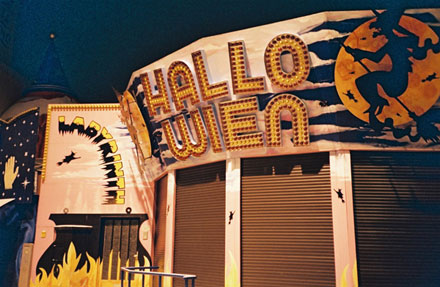 Hallo Wien: a labyrinth located at the heart of the Prater, Vienna's permanent funfair (photo: Anthony Auerbach)
Hallo Wien: a labyrinth located at the heart of the Prater, Vienna's permanent funfair (photo: Anthony Auerbach)Hallo Wien: The Appearance of Klub Zwei
The point is to describe appearances.
In 2005, works by Klub Zwei (Simone Bader and Jo Schmeiser) appeared in Vienna: posters along tramline D as part of the Art in Public Space project Works Against Racisms [note 1], new video works at Secession in their own exhibition entitled In Co-operation With [note 2], recycled works in How Society and Politics Get in the Picture [note 3], a group show at Generali Foundation. The book Things. Places. Years. The Knowledge of Jewish Women [note 4] appeared in print and the film Things. Places. Years. [note 5] was screened several times along with various public discussions.
Mostly I was not there. But, since an article I wrote about Things. Places. Years. was reprinted in the Secession catalogue, I also appeared in Vienna — from a distance. My location at the time of writing (Los Angeles, 2004), which had appeared at the foot of the piece when it was first published, unexpectedly rose to the top when it was reprinted in Vienna. I had written about getting to know Jo and Simone in London and about how they got to know the women who took part in Things. Places. Years. I described the film as recording 'a process of coming to terms with the knowledge of an absence: the absence through which the past makes itself present in a city such as Vienna.' [note 6]
Reading my article again in 2005, meant coming to terms with my own presence in Vienna and confronting how Klub Zwei's work appeared in the city. Writing again means attempting a site-specific interpretation of Klub Zwei's appearances. The critique is therefore addressed to Vienna.
Hallo Wien. This is where I want to start. At an exact address: the Second District, at Rondeau, near the corner of Leichtweg (Easy Way), between an astrological kiosk and Hell. At the heart of the Prater, Vienna's permanent funfair, 'Hallo Wien' appears above the door of a labyrinth: a maze of mirrors, invisible barriers and deceptive surfaces, entrance two euros. There is not much difference between here and the city on the other side of the Danube Canal. The zone of sensation, chance and mechanical entertainment repeats its past and declares its modernity as vehemently as the city whose officials assert it to be the 'world capital of culture' [note 7]. The difference is only that the Prater is somehow exempt from the city's regime of repression (which it does not contest).
I choose this location because it is inside the city limits. The place does not give me a distance, still less objectivity, but instead, the possibility of making things visible. The other places I shall discuss are where Klub Zwei's works appeared.
It is no surprise that the monsters which advertise the trivial terrors of the Prater's ghost trains — reinstated after the Second World War — preserve the grotesque anti-Semitic and racist caricatures which haunted European culture for centuries. It is no surprise either that the city of culture should shun such obviously vulgar configurations of fear.
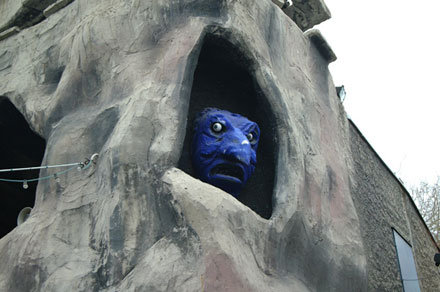 The monsters which advertise the trivial terrors of the Prater's ghost trains preserve grotesque anti-Semitic and racist caricatures. (photo: Anthony Auerbach)
The monsters which advertise the trivial terrors of the Prater's ghost trains preserve grotesque anti-Semitic and racist caricatures. (photo: Anthony Auerbach)Bei uns in Wien (At home in Vienna) is a work by Klub Zwei produced on posters and in the press (2002). The words come from interviews with women in London, mostly Jewish women, some of them born or brought up in Vienna until forced to leave because of anti-Semitic persecution. Klub Zwei's work, that is, selecting the words and embodying them in a distinctive graphic identity — a stark, black-white-red typography they have developed using a typeface originally designed for airport signage — brings the message home [note 8]. In a passage cut out by Klub Zwei, Ruth Sands remembers her parents speaking about Vienna. Whenever her father began, 'Bei uns in Wien ...' ('At home in Vienna ...'), her mother would interrupt angrily, 'Es gibt nichts zu sagen.' ('There is nothing to say about it.') 'She left Vienna and she was, I think, thirty-three and it was as if her life started when she was thirty-three.' [note 9]
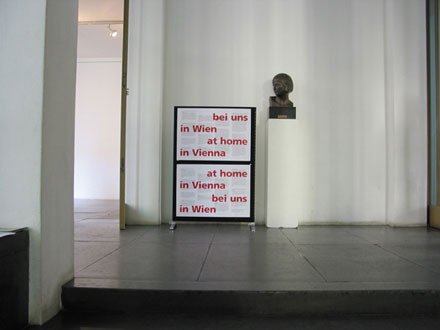 Bei uns in Wien (At Home in Vienna) by Klub Zwei, Wittgensteinhaus, Vienna. (photo: Rainer Egger)
Bei uns in Wien (At Home in Vienna) by Klub Zwei, Wittgensteinhaus, Vienna. (photo: Rainer Egger)Klub Zwei want to speak about the legacy of emigration, for the survivors of the Holocaust and their children, and for the place from which they fled. Klub Zwei's work hints, without saying anything, at the distortions in language and society inherited and propagated by the descendants of those who permitted, supported, facilitated, executed or benefited from the persecution, expulsion and murder of the Jews of Vienna.
Secession, Association of Visual Artists, 1., Friedrichstrasse 12, entrance six euros (includes the Beethoven Frieze)
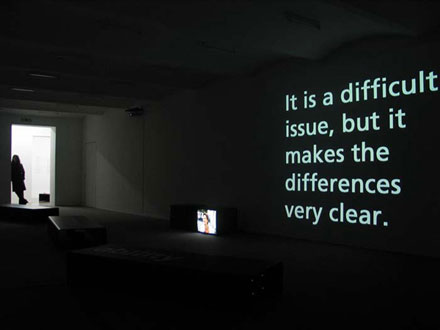 Klub Zwei. In Zusammenarbeit mit, installation view, Secession, Vienna. (photo: Klub Zwei)
Klub Zwei. In Zusammenarbeit mit, installation view, Secession, Vienna. (photo: Klub Zwei)Appearing again in a video by Klub Zwei recorded in Vienna in 2005 and exhibited in the basement of the Secession, Ruth Sands has not much to add to her mother's silence about Vienna. She can speak a little of her feelings as a visitor. She can speculate with Katherine Klinger (who also takes part in the video) on a personal history without the interruption of emigration. But this speculation leads nowhere. The two of them wonder who in Vienna knows or cares that the city lost some 190,000 inhabitants. [note 10]
What Ruth's mother cannot speak about, Vienna passes over in silence. But whereas Ruth's mother's silence insisted on interruption — an irreparable break in her life — it is as if Vienna's silence claims the opposite. It is as if for Vienna, losing its Jewish population — many of whom were influential in the artistic and intellectual life of the city — is not a cultural catastrophe from which the city has never recovered (as seems obvious to Ruth and Katherine), but rather a misfortune which luckily did not happen to 'us' the Viennese, but happened to 'them' the Jews.
Klub Zwei's aim, 'in co-operation with' [note 11] the women who speak in the videos, to expose Vienna's silence, is to interrupt it: to break the self-serving illusion of continuity which allows Vienna's official culture to celebrate the achievements of artists and intellectuals in the city in the first decades of the twentieth century without acknowledging how the conditions of such production were destroyed. Klub Zwei's didactic insistence — how they address their audience — however, inscribes a division between the 'perpetrators' and the 'victims' which undermines the co-operation with a twofold effect. On one hand, reinstating the notion of 'us' and 'them' tends to exonerate the non-victim, the fortunate one, even when it does not explicitly blame the victim. On the other hand, in accordance with the norms of art (as upheld by institutions like Secession), the split encourages the viewer to identify with the victim, and hence narcissistically to recoup the pathos the viewer projects on the image of the victim. Moreover, there is no ambiguity in the interview structure about who is asking the questions and who is supposed to answer them.
This is why the Secession president, in his catalogue foreword, is so sure there are no doubts 'about the side Klub Zwei is on' [note 12], although he does not say which side this is. Klub Zwei themselves say they to belong to the majority, 'perpetrator' side. Theirs alone among the commentaries published by Secession asserts this position. By contrast, other essays in the same catalogue, while recognising the necessity and difficulty of Klub Zwei's work, produce a fog of tortuous or misleading locutions aimed at disclaiming responsibility.
For Hannah Fröhlich, who appears in another video presented by Klub Zwei in the same basement installation, the lure of identifying with the victim is why working together does not work. She explains to Klub Zwei that, in her view, only intensive personal and individual reflection would bring about any changes. But she is not hopeful that Austrians are willing to go beyond comforting generalisations or sentimental dependency on 'victim'-ciphers and instead examine the history of their own families and institutions. For her part, Hannah's own experience and reflections on growing up, living and working in Vienna as a Jew have led her to hand over the responsibility she once imposed on herself as a writer and journalist for (in her words) 'pointing out all the atrocities here'. 'Now,' she says, 'I only do it when I feel like it. When I have fun doing it.' To me, this signifies that a Jewish woman minding her own business is capable of causing panic in Vienna, and she is aware of this power.
Tramline D, 3., 1., 9., between Südbahnhof and Althanstraße, €1.50 a ride, free if you walk
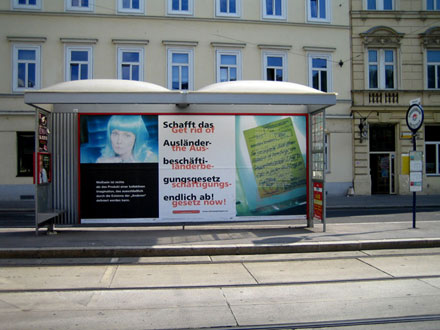 Arbeiten gegen Rassismen, L-R: Anna Kowalska, Klub Zwei/Schwarze Frauen Community, Klub Zwei, Tramstop, Line D, Vienna. (photo: D. Koweindl)
Arbeiten gegen Rassismen, L-R: Anna Kowalska, Klub Zwei/Schwarze Frauen Community, Klub Zwei, Tramstop, Line D, Vienna. (photo: D. Koweindl)In July 2005, tram passengers might have noticed a series of posters at along the route with slogans like, 'Austria needs an anti-discrimination law.' and 'We are black. We are qualified professionals. We demand access to the labour market.' The work of Klub Zwei in co-operation with the Black Women's Community (a small non-governmental organisation, run by and for black women, focusing on developing workplace opportunities for black women and anti-discrimination outreach) would seem to offer the chance to step outside the limits of art practice and the social constraints of institutions like Secession. However, the posters appeared on the streets not as part of a political or an advertising campaign, but as the result of an Art in Public Space commission. Statements such as the ones I mentioned already, or 'Get rid of the Ausländerbeschäftigungsgesetz [law restricting the rights of foreign workers in Austria] now!' are controversial in Austria and one should question why they are not part of everyday political discussion, why a vigorous campaign to implement the necessary legislative changes (if only to conform with EU standards) is not carried out by any political party and why raising awareness of workplace discrimination is not carried out by any government agency. However, in the present context, questioning the meaning of Art in Public Space is more to the point.
Art in Public Space is an initiative intended, according to an official statement, 'to further consolidate [the City of Vienna's] position in the visual arts.' [note 13] A brief look at an example is probably the best way to read between the lines. Handlungsanweisen (Instructions) is a project originally launched by Kunsthalle Wien as a permanent installation and adopted by Art in Public Space as a temporary one: as a step towards the City's goal of 'enhancing' the Karlsplatz area 'as a leisure-time attraction.' 100 artists accepted the commission to devise instructions addressed to passers-by which were posted around Karlsplatz and Resselpark on bright yellow notices advertising the Kunsthalle. They thus assume a place in a system of authority: the art institutions (and ultimately governmental authorities [note 14]) decide who qualifies as an artist and therefore who is authorised to instruct the public. The instructions of course have no effect, except to inscribe this hierarchy in 'public space' and instrumentalise the artists' statements alongside other measures (such as by-laws, defensive street furniture, increased lighting, video surveillance and police patrols) the City is deploying towards achieving its goals for this 'problematic urban zone' [note 15]. The chief function of the artists' work is simply occupation: taking up the space in public which might otherwise be appropriated for some unauthorised message or intervention.
Most public art projects are more subtle and probably more effective in extending the control of so-called public space and defending it for the leisure class. In a place like Vienna, whose city centre is already dominated by cultural institutions and their exclusive publics, Art in Public Space recruits artists to the cause of preventing the contestation of public space.
Unusual occurrences such as the appearance of slogans calling for an end to racial discrimination in the job-market are harmless as long as the worst they threaten is an art scandal and a tedious discussion about what is or is not art. Appearances such as Klub Zwei's contribution to Works Against Racisms serve the sponsoring authorities because, in so far as they are mediated by recognised and approved artists, using an elegant and accepted visual language, they create the false impression that the issues they evoke are a significant part of public discourse. The result is, public scrutiny is deflected from the reality that such issues are officially neglected, and the possibility of a political intervention in public space — by black women, for example — is undermined.
The Black Women's Community welcomes the co-operation with Klub Zwei and the association with Art in Public Space, because they know well enough that an alliance does not require identical interests. They know that the artists will gather the approval of their peers while they, the black women, will run the risk of public hostility. Nonetheless, it is important for them to appear in public, for their statements to be visible, and where possible to gain sympathisers. In any case, they were not planning any major demonstrations. As Beatrice Acheleke, founder and chairwoman of the Black Women's Community explained to me, as long as minorities are as vulnerable as they are in Austria, mobilising communities to collective action is extremely difficult. 'Paralysed' is the word she used. It must be made clear, however, that social paralysis affects the whole body politic.
Generali Foundation, 4., Wiedner Hauptstrasse 15, entrance six euros
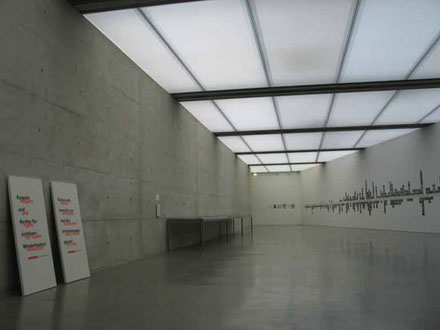 Wie Gesellschaft und Politik ins Bild kommen, L-R: Klub Zwei/Schwartze Frauen Community, Bureau d'études, Hans Haacke, Generali Foundation, Vienna. (photo: Klub Zwei)
Wie Gesellschaft und Politik ins Bild kommen, L-R: Klub Zwei/Schwartze Frauen Community, Bureau d'études, Hans Haacke, Generali Foundation, Vienna. (photo: Klub Zwei)Following an invitation to take part in a group show on a political theme, Klub Zwei suggested exhibiting their recent co-operation with the Black Women's Community. The organisers also agreed to place a banner reading 'Respect and rights for visible minorities!' on the street where they usually advertise the current exhibition. Inside, the tramstop poster designs were reproduced, reduced in size, on specially-made panels. Visitors were also provided with background materials to browse. The rest of the exhibition included works by eight other artists from the 1970s to the present day, some from the Generali collection (e.g. Adrian Piper's Black Box/White Box, 1992), others on loan (e.g. Hans Haacke's Gallery Goers' Residence Profile, Part 2, 1970–71).
Here, in a private art museum, the meaning of the slogans, which had survived the negotiations, compromises and crossed purposes it took to get the posters out on the street, is engulfed by the meaning of their appearance. That is to say, in this environment, the specific content of the work and the original motives for making it tend to be reduced to 'society and politics' in general. 'How society and politics get in the picture' is a question of comparative aesthetics in which the artists are privileged, but still cannot determine the meaning of their work. The banner which stood in for the exhibition advertisement, with its apparently unambiguous slogan, displayed the irony of using the term 'visible minorities' to mark the place where the people to whom it refers are made invisible [note 16].
A museum functions to authenticate the objects it assembles, while isolating them from the actual social and political contexts where they first emerged and where they re-emerge from the archives. Under the regime of art, does it matter which war Martha Rosler feels bad about? Does it make any difference if you are confronted with injustice and brutality from Los Angeles in the 1990s or present-day Vienna? Are visitors to the Generali 'foundation' any more or less mystified by the addresses of New York gallery goers in the 1970s or the transcription of antique fantasies of a world government? Once society and politics 'get in the picture', the viewer is only required to make aesthetic judgements.
The more is required of the viewer, the more difficult the work of Klub Zwei becomes (for the viewer and for Klub Zwei).
Anthony Auerbach
Vienna, February 2006
About the author
Anthony Auerbach is an artist from London. From 1999 to 2004 he ran a visual arts programme for the Austrian Cultural Forum in London and became a regular visitor to VIenna. The aim of the programme was to create a context and platform in London for artists' initiatives and international co-operation. It included exhibitions, new commissions, residencies, performance, lectures and public discussions involving artists from many countries. It gained recognition for innovative and sometimes audacious projects and was the occasion for the beginning of many warm friendships.
Notes
- Arbeiten gegen Rassismen, 1–31 July 2005, along tramline D between Südbahnhof and Althanstraße. Project organised by Daniela Koweindl, Martin Krenn with Ljubomir Bratic, Petja Dimitrova, Richard Ferkl, Anna Kowalska, Klub Zwei, Daniela Koweindl, Martin Krenn, Schwarze Frauen Community. [back to text]
- Klub Zwei. In Zusammenarbeit mit, 15 September–13 November 2005, Secession, curated by Rike Frank and Annette Südbeck. [back to text]
- Wie Gesellschaft und Politik ins Bild kommen, 16 September–18 December 2005, Generali Foundation, curated by Sabine Breitwieser. [back to text]
- Things. Places. Years. Das Wissen Jüdischer Frauen, Simone Bader, Jo Schmeiser (eds.), Innsbruck: Studien Verlag Tirol, 2005. [back to text]
- Things. Places. Years., 70 min, English with German subtitles, 2004. [back to text]
- 'Things. Places. Years. a film by Klub Zwei' in Lasso, Lüneburg: Halle für Kunst, 2004, reprinted in Klub Zwei. In Zusammenarbeit mit., Vienna: Secession, 2005. Read it here. [back to text]
- 'Welthauptstadt für kultur': Festwochen speech by Andreas Mailath-Pokorny. [back to text]
- Klub Zwei published the texts in 'alternative' magazines such as Female Sequences and in the mainstream press (Der Standard) under the auspices of Museum in Progress, 2002. [back to text]
- Bei uns in Wien, poster, 2001. See
also Things. Places. Years. [back to text]
 view poster (English) PDF
view poster (English) PDF
 view poster (German) PDF
view poster (German) PDF - Estimate including all whom the Nazis regarded as Jewish, about 11% of the population. [back to text]
- I understand the title of the Secession show as a signal of Jo and Simone's collaborative practice and acknowledgement of the other women's contributions to the work as interlocutors, on or off screen. [back to text]
- Matthias Hermann in Klub Zwei. In Zusammenarbeit mit., Vienna: Secession, 2005, p. 3. [back to text]
- 'Ihre Positionierung im Bereich der bildenden Kunst.' Art in Public Space is a joint initiative by City Councillors Andreas Mailath-Pokorny (Cultural Affairs and Science), Werner Faymann (Housing, Housing Construction and Urban Renewal) and Rudolf Schicker (Urban Development, Transport and Traffic). http://www.publicartvienna.at [back to text]
- Public funding of culture is not independent of government in Austria, but is part of a system of patronage. The artists and experts who sit on advisory panels are usually also clients of the funding organisations and their decisions are usually subject to political approval. [back to text]
- Gerald Matt, curator's statement, Handlungsanweisen, Kunsthalle Wien leaflet, no date. [back to text]
- One should also question the applicability of the term 'visible minorities' in the Austrian context. The term is used officially in Canada and occasionally in the UK to refer inclusively to a variety of ethnic groups in the context of the monitoring and implementation of equality laws and multicultural policies. The term emerges from political and historical (especially post-colonial) conditions which are remote from Austria. [back to text]